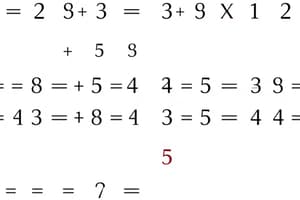Podcast
Questions and Answers
In a set with n elements, how can the number of k-combinations be denoted mathematically, and how is it calculated using factorials?
In a set with n elements, how can the number of k-combinations be denoted mathematically, and how is it calculated using factorials?
The number of k-combinations in a set with n elements is denoted as C(n, k) or C_k^n. It is calculated using factorials as $C(n, k) = \frac{n!}{k!(n-k)!}$.
What conditions determine whether two combinations are identical, and how is the number of k-combinations affected by these conditions?
What conditions determine whether two combinations are identical, and how is the number of k-combinations affected by these conditions?
Two combinations are identical if and only if each combination has the same members, and the arrangement of the members in each set does not matter. The number of k-combinations is affected by these conditions as it is equal to the binomial coefficient, which can be written using factorials as $C(n, k) = \frac{n!}{k!(n-k)!}$ whenever $k \leq n$, and which is zero when $k > n$.
Explain the concept of a k-combination of a set S in mathematics.
Explain the concept of a k-combination of a set S in mathematics.
A k-combination of a set S in mathematics is a subset of k distinct elements of S. It represents a selection of k items from the set S, where the order of selection does not matter.
Using the example of three fruits, how many combinations of two can be drawn from the set of fruits, and what are those combinations?
Using the example of three fruits, how many combinations of two can be drawn from the set of fruits, and what are those combinations?
What is the binomial coefficient and how is it related to the concept of combinations in mathematics?
What is the binomial coefficient and how is it related to the concept of combinations in mathematics?
Flashcards are hidden until you start studying
Study Notes
Combinations in Mathematics
- A k-combination of a set S is a selection of k elements from the set, without regard to the order of the elements.
- The number of k-combinations can be denoted mathematically as C(n, k) or "n choose k".
- The number of k-combinations can be calculated using factorials: C(n, k) = n! / (k!(n-k)!)
Identical Combinations
- Two combinations are identical if they contain the same elements, regardless of their order.
- The number of k-combinations is affected by the conditions of whether the order of the elements matters and whether repetition of elements is allowed.
Example: Combinations of Fruits
- Consider a set of three fruits: {apple, banana, orange}.
- The number of combinations of two fruits that can be drawn from this set is C(3, 2) = 3! / (2!(3-2)!) = 3.
- The combinations of two fruits are: {apple, banana}, {apple, orange}, {banana, orange}.
Binomial Coefficient
- The binomial coefficient, denoted as C(n, k) or "n choose k", represents the number of combinations of k elements from a set of n elements.
- The binomial coefficient is related to the concept of combinations in mathematics, as it provides a way to calculate the number of k-combinations of a set.
Studying That Suits You
Use AI to generate personalized quizzes and flashcards to suit your learning preferences.




